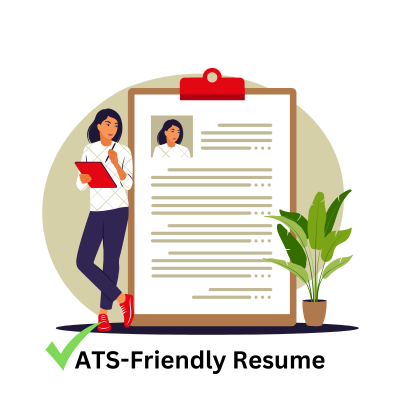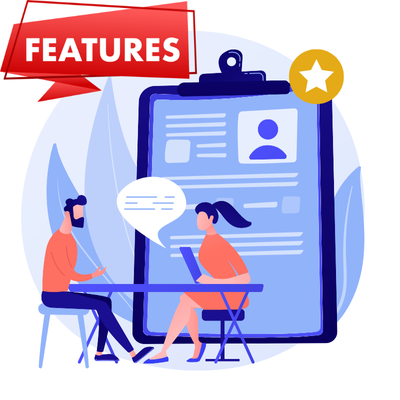If you’re job hunting in tech, creating an ATS-friendly resume can be the difference between landing an interview or being filtered out before a human even sees your application. But here’s the good news—building a resume that passes applicant tracking systems (ATS) is easier than you think, and it can dramatically boost your chances of getting noticed. This step-by-step guide will teach you how to create an ATS-friendly resume, complete with the best templates, tips, and examples to help you rise above the competition. Whether you’re a DevOps professional, a recent graduate, or transitioning into a new career, this guide will show you how to craft a resume that gets results.
What is an ATS-Friendly Resume?
An ATS-friendly resume is designed to be easily read and understood by applicant tracking systems, which are software tools that many companies use to scan, sort, and rank job applications. These systems filter resumes based on relevance, primarily by identifying keywords, parsing formats, and analyzing content. However, not every resume is ATS-compatible. Complex designs, unusual fonts, or non-standard formatting can confuse ATS software, leading to your application being rejected—even if you’re an ideal candidate. That’s why it’s essential to ensure your resume is both visually appealing and optimized for ATS screening.

How Applicant Tracking Systems (ATS) Work
Applicant Tracking Systems (ATS) are software tools used by many companies to streamline and automate the initial stages of the hiring process. These systems are designed to scan, analyze, and filter resumes based on specific criteria set by employers. Here’s how ATS software typically functions:
- Resume Parsing: ATS software parses resumes to extract relevant information such as contact details, work experience, education, and skills. This parsing process enables the system to categorize and organize resumes efficiently.
- Keyword Matching: ATS software compares the content of resumes with predefined keywords and phrases provided by employers. Resumes that contain the desired keywords and skills relevant to the job description receive higher rankings and are considered more suitable for further review.
- Resume Ranking: Based on the keyword matching and other criteria, ATS software ranks resumes according to their perceived relevance to the job requirements. Resumes with higher rankings are more likely to be reviewed by human recruiters.
- Automated Filtering: ATS software automatically filters out resumes that do not meet certain criteria, such as lacking specific keywords or failing to meet minimum qualifications. These resumes may not be seen by human recruiters unless they modify the search parameters or review “rejected” resumes separately.
Why Do ATS Systems Matter?
- Widespread Use: Over 90% of Fortune 500 companies use ATS to screen resumes in bulk.
- First Impression: If your resume isn’t ATS-compatible, it may never make it to the hiring manager’s desk.
- Accuracy: An ATS-friendly resume ensures employers see your key skills and qualifications clearly and accurately.
Benefits of an ATS-Friendly Resume
Before we jump into the how-to, here’s why job seekers should prioritize ATS optimization:
Professional Edge: It demonstrates attention to detail and a strong understanding of industry norms.
Higher Visibility: Your resume is more likely to make it through the initial filtering process.
Better Matching: Ensures your valuable skills and experience align with the recruiter’s keywords.


Key Features of ATS-Friendly Resumes
To boost your resume’s chances of getting past the digital gatekeeper, your document should have the following characteristics:
Clearly Structured Sections: Maintain standard headings like “Experience,” “Education,” and “Skills.”
Clean and Simple Formatting: Avoid graphics, fancy fonts, or unusual layouts that ATS cannot read.
Relevant Keywords: Include role-specific keywords, particularly those mentioned in the job description.
Standard File Format: Use Word (.docx) or PDF files compatible with ATS software.
How to Create an ATS-Friendly Resume in 6 Steps
1. Start with the Right Template
Your resume template matters—a lot. Using a clean, professionally designed format is critical to ensure ATS compatibility.
- What to avoid:
- Tables, columns, and graphs (most ATS systems can’t read these).
- Images, logos, or icons (stick to text-only content).
- What to include:
- Simple, single-column layouts that are scannable.
- Standard fonts like Arial, Calibri, or Times New Roman in a legible size (10–12 pts).
Pro tip: Explore free ATS resume templates available online. Platforms like Canva, Zety, or even Google Docs offer ATS-compatible options to help you get started.
2. Optimize Your Contact Information
Your contact information is typically the first section an ATS scans, so keep it straightforward. Format this section like this for maximum clarity:
- Name: Use your full name at the top in bold, large fonts.
- Phone & Email: Include a professional email address and your primary phone number.
- LinkedIn Profile or Portfolio: Add relevant links if applicable, ensuring the hyperlinks are intact.
Avoid details like photographs, personal addresses, or unnecessary social media links—they can confuse the ATS and aren’t typically required.
3. Tailor Your Resume with Keywords
ATS filters are keyword-driven, meaning the right words can make all the difference. Here’s how to nail it:
- Target the Job Description: Carefully analyze the job posting for repetition of skills or industry-specific jargon.
- For example, a DevOps role might include terms like “Terraform,” “CI/CD pipelines,” or “containerization.”
- Use Action Verbs: Leverage words like “optimized,” “developed,” or “engineered” to highlight your accomplishments.
- Avoid Keyword Stuffing: Focus on naturally incorporating these terms rather than spamming them throughout.
4. Choose the Right Format
Your resume format tells the ATS (and hiring manager) your story. Choose wisely based on your experience level:
- Reverse-Chronological: Best for those with consistent work history in a specific field.
- Functional: Ideal for career changers or those with limited experience.
- Hybrid: Combines features of both and works well for most tech professionals (highly recommended).
Regardless of which format you use, always ensure section headings like “Experience” or “Education” are standard and not custom or creative variations.
5. Showcase Your Skills
Skills are often one of the most important sections in an ATS scan. Use bullet points to list your technical and soft skills systematically.
- Example for DevOps:
- Proficient in tools like Terraform, Ansible, Jenkins, and Docker.
- Expertise in cloud infrastructure (AWS, GCP, Azure).
- Strong problem-solving and collaboration skills.
Exclude irrelevant skills, and prioritize those mentioned in the job description.
6. Keep It Concise and Error-Free
Hiring managers spend an average of 7.4 seconds scanning resumes, so make yours count.
- Be Specific: Focus on measurable results and achievements, not just duties.
- Example: Instead of saying, “Managed cloud migration projects,” say, “Led a 20-member team to migrate legacy systems to AWS, reducing costs by 30%.”
- Proofread Thoroughly: Use tools like Grammarly and Outwrite to eliminate typos or grammar issues.

Common Mistakes to Avoid
Even the best resumes can hit snags if these common pitfalls aren’t addressed:
Submitting the Wrong File Format: Always stick to .docx or a simple PDF to be safe.
Using Fancy Design Elements: Tables, charts, or elaborate designs will often confuse ATS software.
Overloading Keywords: Recruiters can differentiate between authentic qualifications and keyword spamming.
Free ATS Resume Templates to Get You Started
If you’re unsure where to begin, here are some platforms offering free, ATS-friendly templates tailored for job seekers at every level:
- Canva: Simple, professional templates customizable for all industries.
- Zety: Known for stylish and functional options.
- Novoresume: Offers a range of ATS-compatible designs with easy editing tools.
- Online resume builder from Microsoft click here
Final Thoughts on ATS-Friendly Resumes
Crafting an ATS-friendly resume is both an art and a science. By using the right template, adding relevant keywords, and following the tips above, you’ll not only make it past the ATS but also impress hiring managers on the other side.
Want to simplify the process even further? Download a free ATS-friendly resume template today and take that first step toward landing your dream job.